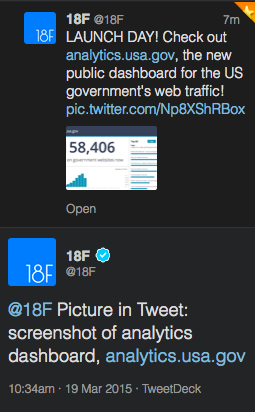Last week, we published this post about the accessibility of images on Twitter. For those of you who haven’t read it, the general gist is as follows: Twitter doesn’t allow alt-tags for images, which makes it difficult for some Twitter users — those with visual impairments and those with slow internet connections — to experience the images as intended.
To increase the accessibility of the images we Tweet, @18F has started replying to photo-centric Tweets with a description of what’s in the photo. Noting this, our followers offered additional suggestions about how we can increase the accessibility of our Tweets. We’d like to thank all of our followers who offered us suggestions, and encourage you to share suggestions, if you have them.

Accessibility is central to our work here at 18F. In a very broad sense, all of our work is driven by a desire to improve the accessibility of federal resources and knowledge. Consider, for example, some of the work 18F is undertaking. Collaborating with USCIS (United States Citizenship and Immigration Services) and others, our team is helping to redesign the USCIS user experience and the content for websites related to immigration and citizenship. In particular, this team is making sure that the recommended path through the sites, along with the sites’ content, is understandable to diverse audiences, thereby making the information more accessible to everyone.
18F is also committed to upholding standards outlined by Section 508, which addresses accessibility in the context of disabilities. Section 508 is (to put it precisely) “an amendment to the United States Workforce Rehabilitation Act of 1973, is a federal law mandating that all electronic and information technology developed, procured, maintained, or used by the federal government be accessible to people with disabilities.”
Put another way, this means that all government websites and electronic resources must be accessible to everyone. Some examples of how the government makes online information more accessible include adding descriptive alt text to images and making sure text contrasts properly with its background.
Improving accessibility and 508 awareness is one of our ongoing goals. In support of this goal, today we hosted a11yhack, a website accessibility hackathon. The hackathon centered on three main activities, including:
- General project collaboration
- Reviews of different websites (including tips for improving accessibility)
- Accessibility-focused talks hosted by guest speakers
The event organizers’ goal was to channel the experience, creativity, and resourcefulness of hackathon attendees to generate new methods of improving websites’ accessibility.
The event had a great turnout, and we’ll be posting a full recap soon. That said, attending this and similar hackathons is far from the only way you can suggest accessibility improvements.
Share your ideas by tweeting them at us (@18F), emailing them to us (18f@gsa.gov), or by creating issues in our accessibility repo on GitHub. As always, thank you for your feedback — together, we can build even more accessible resources.

